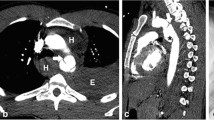Abstract
Objective
Acute traumatic injuries to the larynx, including fractures of the hyoid bone, cricoid, and thyroid cartilage, are uncommon injuries. The purpose of this study was to assess fracture and soft tissue patterns associated with laryngeal trauma.
Methods
This was a retrospective review of patients with laryngeal fractures who presented to two level I trauma centers and underwent CT imaging. Imaging findings, including fractures of the cartilaginous structures of the larynx and hyoid bone, and soft tissue abnormalities including focal hematoma, edema with non-focal hemorrhage, and additional penetrating injuries were recorded. Frequencies of fracture patterns were recorded.
Results
Thyroid cartilage fractures were most frequently observed occurring in 45/55 patients, followed by cricoid fractures in 13/55 patients. Hyoid fractures were encountered in 8/55 patients. Multi-site fractures were observed in 12/55 patients with thyroid-cricoid fractures occurring in 8/12 patients, followed by thyroid-hyoid fractures in 2/12 patients. Most multi-site fractures occurred in association with focal supraglottic hematomas (10/12), supraglottic edema and non-focal hemorrhage (11/12), and focal subglottic hematoma (5/12). All 13 cricoid fractures occurred with either focal supraglottic hematoma (7), focal subglottic hematoma (4), or edema with non-focal hemorrhage (13).
Conclusions
Thyroid cartilage fractures were the most frequently encountered fracture, followed by cricoid cartilage fractures. Cricoid fractures always occurred with soft tissue abnormalities. Recognition of fracture patterns in the setting of laryngeal trauma and associated patterns of soft tissue injury is important for practicing radiologists for early diagnosis of these conditions and reduction of associated morbidity.
Key Points
• Acute fractures to the larynx may be isolated fractures or occur as multi-focal fractures.
• Thyroid cartilage fractures are the most frequent fractures followed by cricoid cartilage fractures.
• Cricoid cartilage fractures always occurred in association with soft tissue abnormalities.




Similar content being viewed by others
Abbreviations
- CT:
-
Computed tomography
- CTA:
-
Computed tomography angiogram
- MDCT:
-
Multidetector-row CT
- PACS:
-
Picture archiving and communication systems
References
Eliachar I (1996) Management of acute laryngeal trauma. Acta Otorhinolaryngol Belg 50:151–158
Bent JP III, Silver JR, Porubsky ES (1993) Acute laryngeal trauma: a review of 77 patients. Otolaryngol Head Neck Surg 109:1–9
Schaefer SD (1992) The acute management of external laryngeal trauma. A 27-year experience. Arch Otolaryngol Head Neck Surg 11:598–604
Madani A, Pecorelli N, Razek T, Spicer J, Ferri LE, Mulder DS (2016) Civilian airway trauma: a single-institution experience. World J Surg 40:2658–2666
Lee WT, Eliashar R, Eliachar I (2006) Acute external laryngotracheal trauma: diagnosis and management. Ear Nose Throat J 85:179–184
Kuniyoshi Y, Kamura A, Yasuda S, Tashiro M, Toriyabe Y (2017) Laryngeal injury and pneumomediastinum due to minor blunt neck trauma: case report. J Emerg Med 52:e145–e148
Trinidade A, Shakeel M, Stickle B, Ah-See KW (2015) Laryngeal fracture caused by a lacrosse ball. J Coll Physicians Surg Pak 25:843–844
Becker M, Leuchter I, Platon A, Becker CD, Dulguerov P, Varoquaux A (2014) Imaging of laryngeal trauma. Eur J Radiol 83:142–154
Narcı A, Embleton DB, Ayçiçek A, Yücedağ F, Cetinkurşun S (2011) Laryngeal fracture due to blunt trauma presenting with pneumothorax and pneumomediastinum. ORL J Otorhinolaryngol Relat Spec 73:246–248
Fitzsimons MG, Peralta R, Hurford W (2005) Cricoid fracture after physical assault. J Trauma 59:1237–1238
Chowdhury R, Crocco AG, El-Hakim H (2005) An isolated hyoid fracture secondary to sport injury. A case report and review of literature. Int J Pediatr Otorhinolaryngol 69:411–414
Humenansky KM, Harris TM, Hoffman DM (2017) Laryngotracheal separation following blunt neck trauma. Am J Emerg Med 35:669.e5–669.e7
Kragha KO (2015) Acute traumatic injury of the larynx. Case Rep Otolaryngol 2015:393978
Becker M, Duboé PO, Platon A et al (2013) MDCT in the assessment of laryngeal trauma: value of 2D multiplanar and 3D reconstructions. AJR Am J Roentgenol 201:W639–W647
Kuttenberger JJ, Hardt N, Schlegel C (2004) Diagnosis and initial management of laryngotracheal injuries associated with facial fractures. J Craniomaxillofac Surg 32:80–84
Shi J, Uyeda JW, Duran-Mendicuti A, Potter CA, Nunez DB (2019) Multidetector CT of laryngeal injuries: principles of injury recognition. Radiographics 39:879–892
Robinson S, Juutilainen M, Suomalainen A, Makitie A (2009) Multidetector row computed tomography of the injured larynx after trauma. Semin Ultrasound CT MR 30:188–194
Parida PK, Gupta AK (2008) Role of spiral computed tomography with 3-dimensional reconstruction in cases with laryngeal stenosis-a radioclinical correlation. Am J Otolaryngol 29:305–311
Sethi RKV, Khatib D, Kligerman M, Kozin ED, Gray ST, Naunheim MR (2019) Laryngeal fracture presentation and management in United States emergency rooms. Laryngoscope 129:2341–2346
Gussack GS, Jurkovich GJ, Luterman A (1986) Laryngotracheal trauma: a protocol approach to a rare injury. Laryngoscope 96:660–665
Jewett BS, Shockley WW, Rutledge R (1999) External laryngeal trauma analysis of 392 patients. Arch Otolaryngol Head Neck Surg 125:877–880
Eaton DK, Kann L, Kinchen S et al (2012) Youth risk behavior surveillance-United States, 2011. MMWR Surveill Summ 61:1–162
Funding
The authors state that this work has not received any funding.
Author information
Authors and Affiliations
Corresponding author
Ethics declarations
Guarantor
The scientific guarantor of this publication is Osamu Sakai.
Conflict of interest
The authors of this manuscript declare no relationships with any companies, whose products or services may be related to the subject matter of the article.
Statistics and biometry
No complex statistical methods were necessary for this paper.
Informed consent
Written informed consent was waived by the Institutional Review Board.
Ethical approval
Institutional Review Board approval was obtained.
Methodology
• retrospective
• diagnostic or prognostic study
• multicenter study
Additional information
Publisher’s note
Springer Nature remains neutral with regard to jurisdictional claims in published maps and institutional affiliations.
Rights and permissions
About this article
Cite this article
Buch, K., Takumi, K., Curtin, H.D. et al. CT-based assessment of laryngeal fracture patterns and associated soft tissue abnormality. Eur Radiol 31, 5212–5221 (2021). https://doi.org/10.1007/s00330-020-07548-4
Received:
Revised:
Accepted:
Published:
Issue Date:
DOI: https://doi.org/10.1007/s00330-020-07548-4




